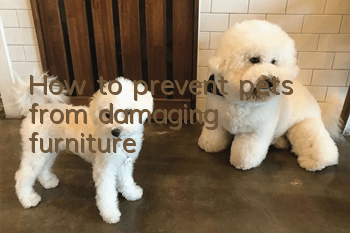How to prevent pets from damaging furniture?

One of the annoying things about pets is that they will treat some furniture as their own territory, or leave shed hair on a clean sofa or bed. When these inconveniences arise, it is important to teach your pet to get off the furniture. Learning how to correct these bad habits can help train your pet to stop causing damage to your furniture.
Method 1 provides alternative places
1. Prepare a comfortable bed for your pet. Before you can train your pet not to sleep on the couch or bed, you need to offer your pet other options. Pets are unlikely to stay away from furniture if you don't provide some kind of replacement. In fact, some pets are better off sleeping on soft furniture because of arthritis pain or discomfort sleeping on the floor. A pet-specific bed can help your pet sleep comfortably without causing you any inconvenience.
2. Prepare a climbing frame nest for your cat. If your cat always likes to climb furniture and cause you trouble, one of the best options is a cat climbing frame. A cat climbing frame allows cats to climb, jump and sleep in one of the "rooms" or platforms.
3. Designate a piece of furniture for your pet. If your pet is not happy sleeping in his or her own bed, consider designating a piece of furniture as a place for your pet to play. It could be old furniture that you won't use anymore - any place your pet likes. However, it is important to train your pet not to climb on other furniture.
It can be difficult for some animals to understand, especially at first, why one piece of furniture can climb but not others. The key to training is consistency, which means any time your pet tries to climb onto other furniture, take it to a designated chair.
4. Use food as a reward. Once you provide your pet with a dedicated bed, "pet-specific" furniture, then you need to train your pet to adapt to this piece of furniture and not harm other furniture. Food rewards are very effective. Placing food on dog/cat beds, cat climbing frames, or pet-specific furniture will make these areas your pet's favorite place. Any time the pet tries to climb onto other furniture, move it to the furniture or bed provided for the pet.
5. Keep pets in cages at night. If your dog or cat keeps trying to crawl into your bed at night, you may want to consider putting them in a crate or confining them to another room. Alternatively, you can close the bedroom door and move your pet out of your room. Just provide your pet with a comfortable bed or blanket and allow it to sleep in a crate or room of your choice.
6. Limit pets’ access to furniture from the beginning. If you have recently brought in a new pet, or plan to get one in the near future, and your pet climbing on furniture is a problem for you, it may be best to restrict climbing on furniture from day one. Once the pet feels that being on the sofa/chair/bed is accepted by the owner, thenIt becomes more difficult (but not impossible) to change this habit, so it is crucial to control this behavior from an early age.
Method 2 Reduce the Attractiveness of Furniture to Pets
1. Keep food away from furniture. Dogs like to climb on the sofa because they know you are eating snacks there and there may be food in the cushions. Or maybe the cat climbs on the kitchen counter because it knows food is there. No matter what kind of furniture your pet climbs on, it's likely that it associates that location with food. Keep food away from furniture and promptly clean up any food waste near furniture.
2. Use double-sided tape. One way to train your pet to stay away from furniture (which works even when you're not home) is to make the furniture less comfortable. Buy some inexpensive placemats and cover one side of them with double-sided clear tape. You can then place these mats, tape-side up, on any counter or couch cushions your pet likes to climb on, or apply the double-sided tape directly to the furniture. The feel of the tape can be very uncomfortable for your pet, but it won't hurt your pet. It won't damage the furniture if you use placemats.
3. Use aluminum foil. Aluminum foil is another simple deterrent method that can make furniture loud and uncomfortable, which your pet won't like, without harming your pet or damaging the furniture. Simply place aluminum foil on sofas, chairs, and countertops. You can also use upside-down plastic rugs for sofa and chair cushions.
4. Prevent pets from coming into contact with furniture. An easy way to keep pets away from couches and recliners is to create barriers such as folding chairs and cushions. This will make the furniture inaccessible to your pet, thereby eliminating the temptation of the furniture.
5. Use gentle traps. One way to prevent pets from climbing on your furniture, especially when you're not home, is to place a gentle bait. A good example of a harmless (but effective) trap is stacking a bunch of empty cans on furniture. Make sure empty cans are cleaned and do not stain furniture. You can stack a small pyramid on your sofa cushions or armchair. If your pet tries to climb on the furniture, the falling cans will scare the pet away from the furniture. Over time, enough to keep it off the furniture forever.
6. Purchase high-tech deterrent devices. If you can't make your own deterrent, there are many high-tech deterrents on the market. Simply speaking, the function of these devices is that they can detect when pets climb on furniture, trigger a certain sound, and emit a stream of air to scare pets and make them stay away from the furniture. Many devices have proven to be very effective as they will scare your pet without causing any harm and can be used even when you are not at home.
Method 3: Train pets to obey the “leave” command
1. Observe the sofapets on. Although the training command is efficient, it requires you to observe the process of your pet climbing on the furniture. This method works better with dogs because dogs follow verbal commands better than cats. When you see your pet climbing on the sofa or chair, instead of simply chasing it off (which may cause an aggressive reaction), train your pet to obey the "leave" command.
2. Order the pet to leave and give a reward. Once you observe your pet climbing onto the couch, say "get off" in a calm yet stern voice. Then hold a bit of food in front of the pet and slowly lift the food (in front of the dog's nose) from the couch or chair to the floor.
3. Praise the dog repeatedly. Once the dog comes off the furniture, verbally praise and reward. At the beginning, reward the pet every time you leave, and then gradually stop rewarding. Eventually you should be able to get your pet to leave the furniture with just a verbal command.
Method 4: Find alternative strategies
1. Let pets do more exercise. One possible reason why pets like to climb furniture is because they don't get enough exercise and stimulation every day. If you don’t have a cat climbing frame, provide scratching posts and interactive toys for your cat to chase, run and jump. This should tire your pet and eliminate the need for your pet to climb, scratch, and explore furniture.
2. Use chemical deterrents. Cats and dogs have a natural aversion to anything that smells like citrus or bitter apple. Take advantage of this when you're training your pet to leave furniture. This effect can be achieved by using citrus-scented cleaning products in areas you want your pets to stay away from, or spraying a little citrus oil or bitter apple on your couch. (Make sure the furniture doesn't get ruined by grease, of course!) Both dogs and cats are repelled by these odors, and if you make an environment smell like these unpleasant odors, dogs and cats will stay away.
3. Crate or confine your pet. If your pet likes to climb on furniture when the owner is not home, consider keeping the pet in a cage while the owner is away or confining the pet to a designated area, such as the bathroom or kitchen. Baby gates can also be used to prevent pets from entering certain rooms or climbing on furniture. Pets can be kept anywhere as long as the animal has access to food and fresh, clean water and is at a comfortable temperature.
- How to care for Samoyed's hair to become smooth and shiny?
- What skin diseases do dogs have? How to treat dog skin diseases!
- What should I do if my injured dog likes to lick its wounds?
- Adverse reactions after vaccination in dogs
- What’s the best way to treat alopecia areata and hair loss in dogs?
- Symptoms and treatment of Samoyed toe inflammation
- What should I do if my dog’s ears are itchy and have ear mites?
- Symptoms of pyrozoonosis in dogs | Diagnosis and treatment methods
- Why does a puppy have diarrhea? Novice owners need to have the following knowledge
- Why do pets smell bad? Is it helpful to use Aineng pet deodorant?



